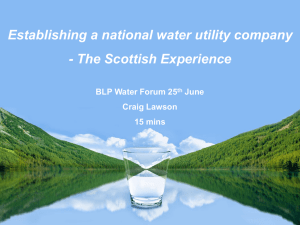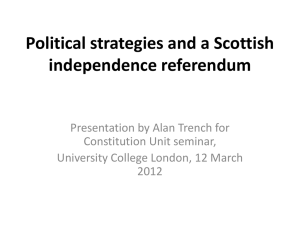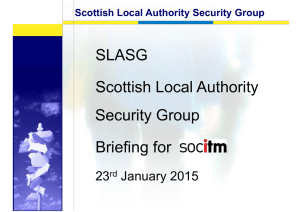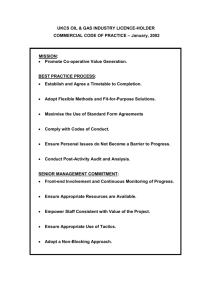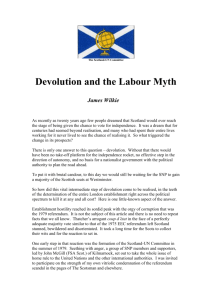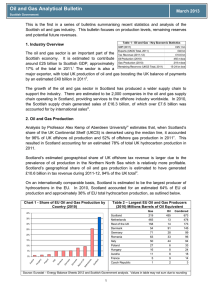Gordon slides - Scottish Constitutional Futures Forum
advertisement
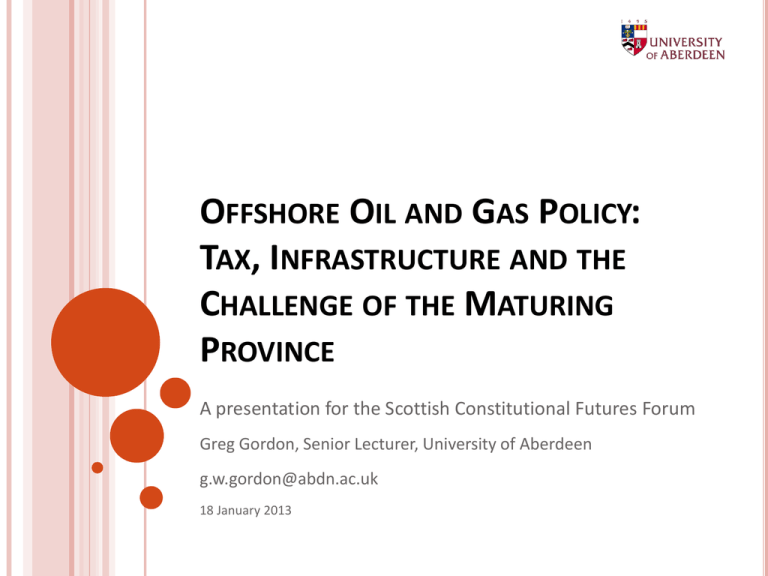
OFFSHORE OIL AND GAS POLICY: TAX, INFRASTRUCTURE AND THE CHALLENGE OF THE MATURING PROVINCE A presentation for the Scottish Constitutional Futures Forum Greg Gordon, Senior Lecturer, University of Aberdeen g.w.gordon@abdn.ac.uk 18 January 2013 CONSTITUTIONAL OPTIONS Status quo Devolution plus No change to tax or upstream oil and gas policymaking positions. Devolution Max Tax and policymaking are devolved to Scotland. Independence Light Oil and gas within the Scottish sector become part of the sovereign rights of the new Scottish state. The possibility of sharing some regulatory/administrative bodies with R-UK. Independence 2 OVERVIEW OF CURRENT OIL AND GAS TAX LAW (1) Licence fees make up a very small proportion of UK’s take from oil and gas production. Royalty was a feature of the system in the early days but has been phased out. Specialised tax system in place: Corporation Tax Supplementary Charge (subject to many field allowances : small fields, heavy oil, remote gas, high-cost brownfield etc) Petroleum Revenue Tax (charged on a field basis, again, complex allowances and the right to claw back field losses against PRT paid in earlier years.) 3 OVERVIEW OF CURRENT OIL AND GAS TAX LAW (2) Commentators such as Prof Alex Kemp generally consider the overall effect of the UK system to be “not bad” but criticise the system for its complexity. There have also been issues with stability. “Tax grabs” e.g. in the form of supplementary charge by parties of all political colours. If oil and gas tax policy were devolved or if Scotland were to become independent, the Scottish government could overhaul and simplify tax law in an attempt to make the S-CS more attractive to global investors. Would however have to be careful not to engage in “the race to the bottom.” 4 OIL AND GAS TAXATION Some key questions In the event of independence or the devolution of matters of oil and gas taxation for S-CS: Can a Scottish share be readily identified? How much money are we talking about? Are there any risks or challenges? If so can, to what extent can these risks be mitigated and the challenges overcome? 5 CAN A SCOTTISH SHARE BE READILY IDENTIFIED? Share per capita or share by geographical extent? (Geographical plainly more advantageous to Scotland) If geographical extent, one issue would be determination of the Scottish and R-UK shares of the Continental Shelf. PRT: any question of oil or gas fields straddling the dividing line apart, a straightforward issue as a highly geographical tax (based on fields) Economic modelling done on the basis of the median line but other possibilities exist. (Straddling oilfields could be dealt with in accordance with the industry norm of unitisation). CT & SC not charged on field basis so would require a sharing mechanism 6 HOW MUCH MONEY ARE WE TALKING ABOUT? Hypothetical Scottish Royalty and Tax Revenues from the UKCS (£m. at 2009/10 prices) 30000 25000 20000 15000 10000 5000 0 7 Source: Kemp & Stephen RISKS AND CHALLENGES (1) Volatility and uncertainty. Long term estimates by the EIA vary between a low estimate of $50 per barrel and $200 per barrel The move towards decarbonisation of the energy sector The potential development of onshore unconventional gas in Continental Europe and England and Wales – could reduce gas price (unlikely to affect oil, which is in any event more valuable). Ageing infrastructure/asset integrity Often seen as a HSW and Environmental issue but has production consequences too – shut in of shared infrastructure has serious impacts upon ability to produce 8 RISKS AND CHALLENGES (2) Inter-connectedness of oil and gas taxation and policy Two sides of the same coin: policy to encourage development in the maturing UKCS involves a combination of tax breaks and policy initiatives and a creative licensing; generous tax allowances set off against decommissioning, etc The danger of a policy-setter with nothing at stake. Potentially divisive esp. if a given policy seen to fail “they’ve ruined it for us...” The need to receive and become conversant with a vast amount of technical and financial data The need to quickly develop a high degree of regulatory competence The danger of “regulatory capture” or “groupthink” if too many regulators are appointed from industry; and the risk of lack of industry knowledge if they are not. 9 MITIGATING RISKS AND ADDRESSING CHALLENGES (1) Volatility and uncertainty. The move towards decarbonisation of the energy sector Borrowing power a necessity, with or without oil fund. Renewables capacity - to what extent does this allow us to hedge the risk? Carbon Capture and Storage (although this is some way off), energy efficiency permitting continued but better use of hydrocarbons The potential development of onshore unconventional gas in Continental Europe and England and Wales Could have a potential impact upon gas price; but query how quickly this will develop; oil price not impacted. 10 MITIGATING RISKS AND ADDRESSING CHALLENGES (2) Ageing infrastructure/asset integrity Intense focus on maintenance; but recognise that unplanned shutdowns are going to be a feature of the mature province. Inter-connectedness... Couple together. Devolve both or neither 11 OTHER KEY AREAS OF INTEREST FOR POLICY Oil fund Access to Infrastructure 12 OIL FUND Basis: oil and gas is a non-renewable resource Using it therefore involves diminishing the state’s stock of assets Can average out peaks and troughs in tax revenue Considerations of generational justice & long-term planning A feature of many oil and gas provinces e.g Norway where the Sovereign Wealth Fund (far more modern than one might imagine, dating only from 2000) is now worth more than $300 billion. Not a feature of the UKCS where oil and gas revenues have never been hypothecated Justification for that: see e.g. Scotland Office - “Scotland and Oil” – “needed for current expenditures: can only spend the money once.” True; but can only be extracted once, too. 13 ACCESS TO INFRASTRUCTURE Small-scale nature of most new discoveries and developments (at least in the long-established parts of the UKCS) means that the ability to tie into existing infrastructure is generally fundamental to new development going ahead Simply isn’t financially viable to build large amounts of infrastructure to service a small field Securing access to infrastructure is therefore a key policy objective if ; particularly as there is the risk that the infrastructure will need to be decommissioned. 14 ACCESS TO INFRASTRUCTURE But; there is an issue: The government did not fund and does not own the existing North Sea infrastructure Key parts of the infrastructure is still owned by the parties who installed it There is no one industry position here: there are “haves” and “have nots”. The “haves” may not be especially interested in permitting third parties to use infrastructure because of e.g. liability issues or they may wish to charge more for the infrastructure’s use than the “have nots” can afford. 15 HOW IS THE BALANCE STRUCK? A multi-layered approach involving Private negotiation Legislation (Energy Act 2011) Code of Practice on Access to Infrastructure (ICOP) (available for purchase from Oil and Gas UK) Guidance on Disputes over Third Party Access Constant “churn” as attempt after attempt has been made to resolve the problem (see following slides). A wholly satisfactory solution has yet to emerge. The ownership question imposes fundamental difficulties for government policy. Can only interfere so far in the peaceable enjoyment of property. Are the mistakes of the past being repeated in the frontier areas of the UKCS? West of Shetland follows the same pattern as before. 16 ACCESS TO INFRASTRUCTURE: CHRONOLOGY (1) [Early legislation] [Perceived problems with potential new entrants complaining that difficulties in this regard acted as a barrier to entering UKCS] 1994 - D’Ancona Committee: “More legislation, or an industry code?” (Industry code approach adopted) 1996 - Industry – Rules and Procedures Governing Access to Offshore Infrastructure 1998 - Petroleum Act 1998 – s.17 – Power to set commercial terms if parties can’t agree 2000 - Regulations (the Gas (Third Party Access and Accounts) Regulations 2000) made extensive revisions to the Act – provisions more detailed but fundamental structure remains. 17 ACCESS TO INFRASTRUCTURE: CHRONOLOGY (2) 2001 - Government - Guidance Notes on Disputes (how we will resolve disputes). Little practical guidance on what any given throughput tariff should be. 2004 - Industry – Industry Code of Practice – “play nicely” (but no teeth) 2005 - Government - Revised Guidance Notes on Disputes 2006 - Industry - ICOP Review (patchy compliance) [Problems remain] 2008 - Energy Act 2009 - Industry - Revised ICOP 18 ACCESS TO INFRASTRUCTURE: CHRONOLOGY (3) 2009Government - Revised Guidance 2011Energy Act - stronger government powers to intervene in negotiations 2012 - Government - Revised Guidance: March (“Government will use stronger powers very sparingly”); interim only, expected that further revisals will follow). 2012 - LOGIC (Industry and Government) Review (ongoing) 19




